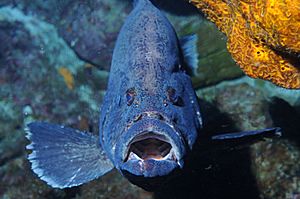Marbled grouper facts for kids
Quick facts for kids Marbled grouper |
|
|---|---|
 |
|
| Conservation status | |
| Scientific classification | |
| Synonyms | |
|
The marbled grouper (Dermatolepis inermis) is a type of fish that lives in the ocean. People also call it the donkey fish, mutton hamlet, rockhind, or sicklefish grouper. It's a grouper, which means it belongs to a family of fish called Serranidae. This family also includes sea basses. The marbled grouper is a predatory fish that lives on coral reefs in the western part of the Atlantic Ocean.
Contents
What Does the Marbled Grouper Look Like?
The marbled grouper has a body that is quite deep and flattened from side to side. It is deepest near its top fin. This fish has a long nose and a steeply sloped head.
Its top fin, called the dorsal fin, has 11 strong spines and 18 to 20 soft rays. The fin underneath, called the anal fin, has 3 spines and 8 or 9 soft rays. It also has large pectoral fins on its sides.
Adult marbled groupers are yellowish-brown. They have many small dark brown spots all over their head, body, and fins. They also have lighter patches on their head and body.
Young marbled groupers, called juveniles, look different. They are dark brown or black. They have white patches scattered unevenly on their head and body. This helps them blend in.
This fish can grow up to 91 centimetres (36 in) long. The heaviest one ever found weighed 10 kilograms (22 lb). However, most marbled groupers are usually around 50 centimetres (20 in) long.
Where Do Marbled Groupers Live?
Marbled groupers live in the western Atlantic Ocean. You can find them along the eastern coast of the United States, from North Carolina down to the Bahamas.
In the Gulf of Mexico, they live from northwestern Cuba up to Alabama. They are also found in special areas like the Flower Garden Banks.
In the Caribbean Sea, they are seen from Cuba to Tobago. They also live near Guanaja Island in Honduras.
Off the coast of South America, they are found from Colombia to Guyana. They also live off Brazil, including islands like Trindade and Fernando de Noronha.
Habitat and Life of the Marbled Grouper
Marbled groupers usually live in deep places in the ocean. They are found between 3 and 250 metres (9.8 and 820.2 ft) deep. They like to live on reefs, especially in caves or deep cracks in the rocks.
This fish is a solitary creature, meaning it lives alone. It is also very shy and secretive. If you get too close, it will quickly dart away to hide.
Scientists don't know much about how marbled groupers reproduce. However, they believe these fish gather together to lay their eggs, just like other groupers do. Young marbled groupers have been seen hiding among the sharp spines of sea urchins for protection.
Discovery of the Marbled Grouper
The marbled grouper was first officially described in 1833. A French scientist named Achille Valenciennes gave it the name Serranus inermis. He found the first examples of this fish near the Antilles islands.
Marbled Grouper and Conservation
The marbled grouper is not a main target for large fishing industries. However, people in Brazil really like to eat its meat. So, both sport fishermen and commercial fishermen sometimes catch them.
One concern for this fish is when they gather to lay eggs. If too many are caught during these times, it could harm their populations.
The International Union for Conservation of Nature (IUCN) has listed the marbled grouper as "Data Deficient." This means there isn't enough information about how many marbled groupers there are. Because of this, it's hard to know if their numbers are going down. However, scientists suspect that the population of this naturally rare fish is decreasing.
See also
 In Spanish: Mero mármol para niños
In Spanish: Mero mármol para niños


